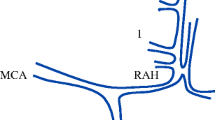Summary
Fifteen patients were observed between 1987 and 1990: there were six with angiographically confirmed vertebral artery dissection, and 9 with carotid artery dissection. Results showed concordance of MRI and angiographic findings, in all cases but one. The dissected portion consistently showed a semilunar hyperintensity narrowing the residual eccentric signal void of the lumen when the artery was not completely occluded. In one angiographically occluded vessel, MR detected a small signal void within the hyperintensity, indicating that the artery was not completely occluded. The length of the dissected portion was clearly demonstrated by MR. Follow up MR and angiographic studies confirmed the regression of the dissection, and also allowed examination of the cerebral parenchyma.
Similar content being viewed by others
References
Petro GR, Wilwer GA, Cacayprin ED, Hodge CJ, Brendenberg C, Jatremski MS, Kieffer SA (1986) Spontaneous dissection of the cervical internal carotid artery. Correlation of arteriography, CT and pathology. AJNR 7: 1053–1058
Greselles JF, Zenteno M, Kein P, Castel JP, Caille JM (1987) Spontaneous dissection of the vertebro basilar system. A study of 18 cases. J Neuroradiol 14: 115–123
Fisher C, Ojeman RG, Robertson GH (1978) Spontaneous dissection of cervicocerebral arteries. Can J Neurol Sci 5: 9–19
Bradly WG, Waluch V (1985) Blood flow magnetic resonance imaging. Radiology 154: 443–450
Mills CM, Brandt-Zawazki M, Crook LE, et al. (1983) Nuclear magnetic resonance. Principles of blood flow imaging. AJNR 4: 1161–1166
Von Schulthess GK, Higgins CB (1985) Blood flow imaging with MR spin phase phenomena. Radiology 157: 687–695
Gomori JM, Grossmann RI, Goldberg HI, Zimmerman RA, Bialianuk LT (1985) Intracranial hematomas. Imaging by high field MR. Radiology 157: 87–93
Goldberg HI, Grossman RI, Gomori JM, Asbury AK, Bilianuk LT, Zimmerman RA (1986) Cervical internal carotid artery dissecting hemorrhage. Radiology 157: 87–93
Bruegieres F, Costec Carpo Herall F, et al. (1989) Magnetic resonance imaging in the exploration of dissection of the internal carotid artery. J Neuroradiol 16: 1
Quint DJ, Spikler EM (1990) MR demonstration of vertebral artery dissection-report of 2 cases. J Neurosurg 72: 964–968
Walluch V, Bradley WG (1984) NMR even echo rephasing in slow laminar flow. J CAT 8: 594–598
Alvarez O, Edwards JH, Hyman RA (1986) MR recognition of internal carotid artery occlusion. AJR 7: 359–360
Russel EJ (1989) Detection of significant extracranial carotid stenosis on routine cerebral MR. Radiology 170: 623
Author information
Authors and Affiliations
Rights and permissions
About this article
Cite this article
Gelbert, F., Assouline, E., Hodes, J.E. et al. MRI in spontaneous dissection of vertebral and carotid arteries. Neuroradiology 33, 111–113 (1991). https://doi.org/10.1007/BF00588245
Received:
Issue Date:
DOI: https://doi.org/10.1007/BF00588245




